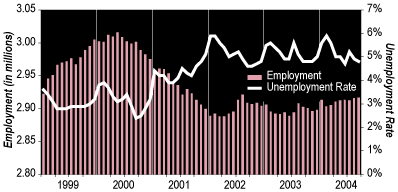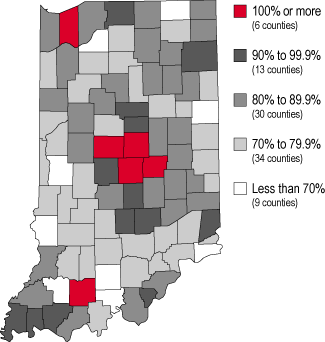Indiana
Indiana Business Research Center, Kelley School of Business, Indiana University, Bloomington and Indianapolis
As the nation’s most manufacturing-intensive state, Indiana often feels the effects of economic downturns earlier than other states, and those effects tend to last longer. That was the case for the most recent recession and recovery period, but Indiana now appears to be slowly regaining the ground it lost over the past few years.
The most-watched indicator of Indiana’s economy is total monthly nonfarm employment (which does not include self-employment). As shown in Figure 1, Indiana’s employment bottomed out in April 2002 at 2,888,000 workers, a decline of 128,000 jobs from the state’s peak employment in May 2000. Since hitting that minimum, Indiana has regained 28,500 jobs as of September 2004—a modest increase to be sure, but an increase nonetheless. Moreover, employment growth is becoming more regular. The state has experienced nine consecutive months of job gains compared to figures from the previous year, the first such streak since 2000. In comparative terms, however, forty-two states have higher job growth rates than Indiana, whose employment growth was 0.5 percent over the past twelve months.
Figure 1
Indiana Seasonally Adjusted Employment and Unemployment, January 1999 to July
2004

An End to Manufacturing Losses?
The largest share of Indiana’s job loss in recent years has come from the manufacturing sector, which lost 104,100 jobs from its December 1999 zenith (when manufacturing accounted for 22.4 percent of all employment in Indiana) to its March 2004 nadir (19.5 percent). Part of this job loss is attributable to outsourcing of work from the payrolls of factories to other organizations (though in some cases the same workers continue to operate under the same roof as before, but for a new vendor firm); while perhaps a larger impact has come from increased productivity. Fortunately, the shrinkage of Indiana’s manufacturing employment appears to have subsided, and the state weighed in with 1,300 more factory jobs in September than in March 2004.
Service sector growth has counteracted shrinkage in manufacturing. Since Indiana’s total employment bottomed out in April 2002, the education and health services sector has shown the largest gains, adding 23,100 jobs; the government sector has added 13,500 jobs; and the business and professional services sector has grown by 7,700. More recently, the sector with the strongest growth over the past twelve months has been construction, expanding by 5.2 percent (7,600 jobs).
Personal Income
Though closely watched, employment does not fully capture the impact of economic change in a state, especially as workers migrate from higher-paying factory jobs to positions in lower-paying industries. A better indicator from this perspective is per capita personal income (PCPI), which shows the average of incomes received from a variety of sources. In this respect, Indiana’s residents earn only 91.5 cents for each dollar earned by the average U.S. resident, according to the latest state and national figures for 2003. This gap has gradually widened over many years. In the state’s rural areas, the gap is even wider, while Indiana’s metro areas have PCPI’s closer to (but still below) the national average (see Figure 2).
Figure 2
PCPI Relative to the Nation, 2002

Indiana’s Outlook for 2005
On balance, Indiana’s economic downturn has begun a slow recovery, and the outlook for 2005 is for modest growth. Several factors argue for a conservative forecast, including rising interest rates, slow growth in the state’s population, and slowing demand for housing and automobiles. In light of these factors, we anticipate that Indiana’s employment will grow by about 15,000 jobs, and the state’s unemployment rate should be near its current level of 4.8 percent by the end of 2005.
Also in this Issue…



